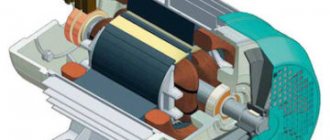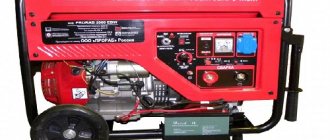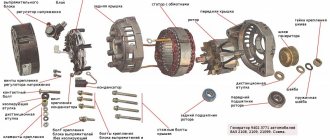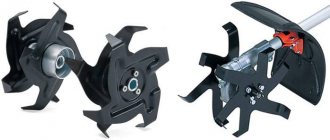A portal user tells how to make an all-weather “garage” for a backup power supply station for a country house.
When it’s winter outside and the lights are turned off, the power plant comes into play. Leaving it “naked” on the street or dragging it from the shed is not an option. What should I do? Assemble the container, equip it with ventilation and an engine heating system to ensure a guaranteed winter start, and place a generator in it. We'll tell you how to make a box that is indistinguishable from the factory version.
House for Elitek.
My gasoline generator
needs a permanent location that is protected from the weather.
The place was chosen about thirty meters from the house (it’s still noisy). It was decided to make a permanent structure with a hard floor covering (there is still vibration), a strong material (40mm metal corner), and walls made of wood (noise absorption). It was purchased on the local market:
40mm corner - for the frame 50mm corner - for 4 supports M300 sand concrete 4 board loops 25*150*6000 - for walls
Found in the change room:
Three different Aquatex paints (teak, walnut and rowan) electrodes for welding self-tapping screws brushes
Found on the site:
bricks, mesh, reinforcement and sand behind the site
We welded a frame 1100 by 1000 from a 40mm corner. We tried on where the structure would stand. Removed the fertile layer of soil. I poured sand, laid bricks and mesh and reinforcement. I hammered in 4 50mm corners into the corners and welded the lower frame to them. Then they welded the frame and filled it with mortar.
Every year my wife’s dad comes to visit us on my vacation. A wonderful person. With his help, we made so many things at our summer cottage.
The next day we welded two frames for the top door and the side one. The top door is needed for refueling, servicing the air filter and carburetor, replacing the spark plug and starting the generator manually. The side door is convenient for connecting loads, starting the generator using an electric starter, and for removing the device from the house for more global maintenance or changing its location.
Today my youngest son Ivan helped us - he painted the frame of the house, while my father-in-law and I painted boards for the walls.
Source
Mini container for generator: step by step with photo
How to make a storage box for an electrical station with your own hands? First, make a list of your requirements and estimate the operating mode of the generator. The type of construction depends on this. An example of a FORUMHOUSE user with the nickname Kostasino will be useful to you.
I made a container for power backup at home. First I bought a 6.5 kW generator, an ATS unit for autostart and made a list of requirements:
The user divided the assembly of the “garage” into stages:
The container lid has a slope. This way the water will roll down in one direction rather than stagnate at the top. To reduce vibration from the engine, a rubber mat was placed on the bottom. I also attached limiter chains to the lid, otherwise when you tilt the lid to a larger angle, you can break the hinges.
Why do power plants burn out and break down: safety precautions when operating a generator
Important! A generator in a box is a high-risk system! See what can result from improper use and choice of container design.
Pay special attention to the ventilation of the generator installed in a container! The example above is that the fuel boiled and the station caught fire. Install thermal protection in the ignition gap and provide for an emergency stop of the generator when the permissible temperature increases. The design of the box must be such that in case of force majeure situations - failure of the emergency system, fire and explosion, the lid is thrown back and the energy of the explosion goes “out into the street”. If you make a steel container, and not from composites, with a rigidly fixed lid, then the explosion pressure will increase severalfold. Steel fragments can injure or kill those passing by or the owner who will put out the fire.
Installing a container for the generator and working on bugs
The user brought the container and generator on a car trailer.
Externally, homemade, no different from the factory model.
Now we’ll tell you how the master solved the problem with insufficient ventilation of the box.
I made the container in winter. I didn't calculate the air exchange. I ran the station at maximum load. There was no overheating, because it's cold outside. But in the summer I tested a box with temperature sensors. Within an hour of operation, the air temperature in the box exceeded 50 degrees Celsius. Is it dangerous. The fuel in the tank may boil. The tank will swell and gases will be released through the filler neck into the box. Having studied the Internet, I found information that this type of engine, as installed on a generator, requires an air exchange of at least 1800 cubic meters. m per hour. To remedy the situation, I ordered 2500 cubic meter WOK fans 3.15. m per hour and put one at the entrance and one at the exit. Now everything works as it should.
The final version of the container for the generator.
The backup power supply system fits perfectly into the suburban area.
Asynchronous
- Synchronous - more complex in their design. Voltage fluctuations lead to malfunctions. This affects work and productivity.
- Asynchronous - with an easy operating principle and other technical characteristics.
Magnetic coils on the rotor of a synchronous generator make it difficult for the rotor to move. The rotor in an asynchronous generator is more like a flywheel.
Design features have a great influence on efficiency. Synchronous ones have a loss of up to 11%. For asynchronous, the loss reaches a maximum of 5%. Such indicators make asynchronous devices popular not only in everyday life, but also in production.
- Frequent repairs are not necessary, because the simple housing reliably protects the engine from spent fuel and excess moisture.
- The output rectifier will protect electrical appliances powered by the generator.
- Resistant to voltage surges.
- All parts in the design are quite reliable and durable, so operation without repairs can last more than 15 years.
- Thanks to its resistance to surges and the ability to power devices with ohmic loads, the number of different devices for connection is growing - from computers to welding machines and lamps.
- High efficiency.
Useful tips Connection diagrams Principles of operation of devices Main concepts Meters from Energomer Precautions Incandescent lamps Video instructions for the master Testing with a multimeter
Answers to questions on how to make a box for a power plant with your own hands
The portal participants liked the homemade product. Kostasino was flooded with questions.
Tell me, does the engine heating work constantly in winter? It is expensive? How much money does it cost for electricity?
Heating cable length 2.5. m. It takes about 40 watts in cold weather. In winter, the heating works constantly to keep the diesel engine in “fighting” condition and make starting easier. The cable is self-regulating. As soon as a positive temperature is established in the box, it reduces electricity consumption and only works to maintain a positive temperature, heating the bottom of the container. It adds up to 300-500 rubles per month, but it’s cheaper than installing a convector.
How much does the container body weigh? Can you make the same one out of steel?
Boxing weighs 81 kg. If you assemble the same one from steel, and not from aluminum composite panels, you won’t be able to lift it at all.
And if the fuel tank is placed outside the container, is this a workable idea?
I've been thinking about such a scheme for a long time. The tank is outside, often placed abroad. But the external tank will not be protected from snow, rain, wind, lightning, or access by strangers. It is best to make a container of two sections - for the generator and an insulated box for the gas tank. I'll be working on a project like this soon.
Main types and their advantages
You can ensure autonomy in power supply in different ways, for example, installing photovoltaic panels or a wind generator. But such technologies are not available to everyone:
- Firstly, they are quite expensive.
- Secondly, it will be difficult to ensure the safety of such property, especially if you do not live in the house all year round.
- And thirdly, energy companies may have questions.
Therefore, connecting a generator often becomes the most profitable and even the only correct solution.
conclusions
We talked about the basic principles of constructing a container for a generator and the features of its operation. If you approach the matter wisely and with straight hands, then, on your own, you can make a box that is in no way inferior to factory models and, most importantly, cheaper. If you still have questions, we recommend that you go to the topic Mini container for a generator and ask them to the author of the box. The topic also presents several more models of homemade containers for gas generators.
Articles that will be useful:
Source
Using a changeover switch
If the middle contacts of the switch are connected to the consumer, and the extreme contacts are connected to the power plant cable and to the mains input, the power supply circuits will never intersect. It will be even better if the switch has another intermediate neutral position.
The initial state of the switch is considered when the main network is connected. When it is switched, power begins to flow from the generator.
The disadvantage of the old-style changeover switch is sparking and openness of live parts. Modern designs are equipped with a protective casing that covers moving parts. The switch is mounted in the control panel. The starting position is the connection to the main network. If there is a power failure, set the shift handle to the neutral position, and then start the generator, warm it up and connect it to the loads in the house.
Generator noise insulation
Recently, more and more often you can find houses or cottages equipped with power plants. The main advantage of an autonomous generator is that it is possible to provide electricity to an object located at a distance from a populated area. For privacy with nature, many people move to remote areas where there is no electricity or running water. If water can be provided to a family using a borehole or a well, then gasoline or diesel generators are used as a power plant.
Photo: Casing for the generator. Author: Artemy Ivanov
A power plant, like any other internal combustion engine, produces a sound during operation, which not only interferes with constant operation, but can also lead to negative consequences. Unfortunately, an engine that will not make noise during operation has not yet been invented, so options for soundproofing the generator should be considered.
Types of electric generators
Gasoline generators are the most common household sources of electricity. Their features are as follows:
- large selection of prices;
- low power - 0.8-12 kW;
- compact mobile and stationary models;
- There is a 3-phase and single-phase generator;
- Four-stroke internal combustion engines are mainly used.
When choosing the option of how to connect the generator to the home network, the cooling scheme of the internal combustion engine depends on whether the unit is used permanently or temporarily. Typically, devices are equipped with air radiators. Industrial models are capable of operating around the clock using liquid cooling. They are produced mainly three-phase. They are larger in size, but more economical.
Connecting a diesel generator to the network in the house is used less frequently due to the high price. But still, its use is advisable due to its large resource.
Power plant noise level
As you know, sounds are transmitted in two ways: through air and vibration. When airborne noise enters the house, a person hears a roar from the engine and exhaust system. As for vibrational sound, it can be transmitted through solid bodies, creating discomfort in the room.
Photo: Sound-absorbing box for the generator. Author: Artemy Ivanov
According to experts, the noise level from a power plant is 100 dB; to make it easier to understand, you should consider which sounds are equal to what.
Loud sounds in the room can not only lower your mood, but also prevent you from resting, and as a result, this problem can lead to diseases of the nervous system. Today, with the help of soundproofing and noise-absorbing materials, you can create ideally comfortable conditions.
Application of the AVR system
An automatic start system is much more expensive than a manual one. However, external control is still necessary, since when starting the internal combustion engine it is necessary to control the throttle valve. After starting, the engine should warm up.
Many people prefer to use partial automation, with the main power connected through a contactor that opens when the input is turned off. The generator is then started manually. A time relay is built into it to warm up the engine and automatically switch to connecting the reserve to the house.
When the power supply is restored, the contactor is switched off and the load is again supplied to the mains.
The reserve with full automation of power supply contains microprocessor control of the operation of powerful generators.
What affects the noise level of a generator?
Essentially, the sound from the generator occurs due to the friction of parts and exhaust from the exhaust system. It is also worth knowing that the volume of noise depends on the type of engine installed on the generator. Today there are three types of generators that are used by humans:
The power plant that produces the lowest noise level runs on gasoline. Gas equipment is considered the second in terms of noise level. There are also combined units that run on gas and gasoline. Depending on the capabilities, the optimal equipment is selected. If the design has an original casing, then the sound during operation of the device will be relatively low.
Diesel generators are much louder; combustion in the engine occurs due to high pressure, resulting in a loud bang. In addition to airborne noise, electrical installations produce a high level of vibration, and to optimize comfort conditions it is worth using sound insulation.
Ventilation device
Good ventilation must be ensured in the generator room. To do this, in the simplest case, you can extend a galvanized iron pipe 0 10 cm outside the roof. But houses built for air-cooled electrical installations require forced ventilation. The fans are installed in the air duct or
built into the wall. Their functions are different: some blow on the running engine of the power plant, others remove hot air from the room.
So, for a portable installation with a power of 6 kW, it is advisable to install two fans with a capacity of 1,000 m 3 /h each. They turn on only when the generator starts and turn off automatically when the engine stops.
It is also necessary to make “bottom” ventilation - a leaky connection between the walls and the floor.
This is necessary so that exhaust gases with a high content of carbon dioxide, which are heavier than air and therefore accumulate below, “flow out” through these leaks from the room. The same applies to gasoline vapors, the accumulation of which can lead to an explosion and damage to all equipment.
From the above, it is clear that the structure for the generating set should not be buried in the ground, since this can lead to the accumulation of exhaust gases and gasoline vapors in the room.
In the generator room you can place shelves for storing tools and additional fuel containers. The brackets supporting the shelves are attached directly to the walls of the house.
An important detail is the switch that disconnects the cottage from the main network before turning on the generator. It should be placed in a visible place on the wall and well insulated from metal surfaces and objects. This safety measure will protect those who maintain the power plant from unexpected power resumption.
Global methods of sound insulation
To suppress the noise level of a running generator at an enterprise, it is necessary to use a separate room. The thing is that the generator power produces high noise, which interferes with operation. An existing structure can be used as a room for the generator or a new structure can be erected. The main requirement of the constructed structure is effective sound insulation. Sip panels, mineral wool or basalt slabs can be used as insulating material. Today the market offers a large selection of soundproofing materials, among which you can choose exactly what you need.
Photo: The generator can be placed outside, isolating it in a special box. Author: Artemy Ivanov
If an existing structure is used, then high-quality noise insulation of the generator must be installed in it. Interior wall decoration is made using sound-proofing and sound-absorbing materials. To decorate the walls of a room you can use: fibrous, porous materials and sip panels. A generator installed indoors will create much less sound.
Spot sound insulation method
As a rule, the generator has several points of contact with the surface. It is through these areas that vibration occurs, which can be transmitted even through hard surfaces: metal, concrete and other surfaces. As an alternative solution, each element that produces vibration can be silenced using soundproofing devices. Currently, some manufacturers offer ready-made soundproofing structures. By placing the device inside the structure, an additional noise insulation barrier is created, as a result of which noise and vibration are significantly reduced. It is important to carefully study the design characteristics so that difficulties do not arise during operation.
Reversing switch
Switching to power from a gas generator is made using a reversing switch. The device usually has 3 handle positions, where the extreme ones close the circuit, and the middle one opens it.
A single-phase circuit is suitable for connecting a backup generator to the network at home with low power consumption, for example in a country house.
The input terminals are located at the top and the output terminals at the bottom. Indicator lamps are installed on the panel to indicate that the network or generator is turned on.
Diesel generators in casing
Closed type generators produce less noise. The casing is made of metal and soundproofing materials. The efficiency of the casing is quite high, which can significantly reduce the noise level by several times.
Photo: Sound-absorbing box for the generator. Author: Artemy Ivanov
The outer skin is made of a metal frame and sewn up with solid sheets. Depending on the model, noise-absorbing casing for the generator, you can find products with control panels specifically for one or another device. A generator in a housing has a more aesthetic appearance, but the main advantage of the design is protection from vibration and airborne sounds.
Tips for choosing equipment
To ensure that the generator works efficiently and you do not have problems with it, take into account a few simple rules:
The functionality of the equipment is determined by the startup type. The simplest summer option is manual activation using a cord. An electric starter does not require brute male strength - just turn the key or press a button. Autostart is useful because it turns on the generator automatically when the power goes out.
Electric generators can be single-phase, rated at 220 V, or three-phase, rated at 380 V. This feature is important to know when choosing a model.
The comfort of residents should not be disturbed by strong noise. Choose gasoline units with a noise level of up to 74 dB and diesel units with a noise level of less than 82 dB. The presence of a casing can significantly reduce sound discomfort.
A large fuel tank increases the operating time until the next refueling, but at the same time the dimensions of the equipment and its weight increase.
Choose models equipped with additional surge protection. A more efficient cooling system is liquid.
The range of equipment suppliers is quite wide. You should choose the right model based on your goals and financial capabilities. But if a generator is purchased as the main source of energy supply, the selection criteria should be more stringent, since reliability, safety, and reliability are especially important here.
Advantages of standard housings
The autonomous power plant installed in the building has a relatively low noise level, which allows the equipment to be used not only outside, but also inside the facility. The metal casing also gives the equipment a more cost-effective appearance. In addition, a protective noise-absorbing casing for the gas generator helps protect the operating mechanism from damage and clogging. Currently, the market offers a large selection of enclosures that can effectively reduce noise levels.
In the manufacture of standard enclosures, the characteristics and features of the equipment are used, which makes it possible to most effectively reduce the sound level from the generator. Depending on the model of the unit, the optimal protective layer of sound insulation is selected. To ensure that the casing remains effective and reliable for a long time, the surface of the casing is painted with a special anti-corrosion paint. The appropriate casing is selected based on the type, model and dimensions of the generator design.
It is worth noting that standard products are initially designed for a certain level of noise, which they effectively absorb. Also, the unit fits perfectly into the frame and is fixed. When purchasing a standard casing, you don’t have to worry about its effectiveness, because all the device’s parameters of interest are indicated in the instructions, as well as the characteristics. Such products must have a quality certificate, which will help you buy an original product from the manufacturer.
Model types
Installations that generate electric current are divided into types.
- Asynchronous. The design is simple and reliable. Important components are protected from moisture and dust. It is preferable to use devices for active loads. It is not recommended to use asynchronous generators to power electric motors.
- Synchronous. The units do not have the disadvantages characteristic of asynchronous ones. In addition, they maintain a more precise voltage. You need to choose a brushless design, which has much better current characteristics and less radio interference.
- Inverter models are more expensive and have less power. The characteristics of single-phase devices are worse, especially for cheap models. A 3-phase generator is slightly better. Other disadvantages are high cost and less reliability.
Do-it-yourself noise-insulating casing for a generator
Purchasing a standard casing for a generator is not an easy and expensive task. Do-it-yourself noise insulation of a gasoline generator will help you make a design with the appropriate parameters and save on purchases. Using soundproofing materials, you can make a casing yourself, spending a little time and saving your own money. There are two options for making a casing that you can make yourself. The first option involves the use of expensive materials such as cork panels. As for the second manufacturing method, it differs in composition and materials used in the design.
Option one (quality)
The process of making a casing with your own hands is simple and includes several stages:
When all structural elements are fixed and dried, a generator can be placed in the product. Thanks to this casing design, the noise level of the generator is significantly reduced, which in turn contributes to the comfort of people living nearby.
Option two (cheap)
As for the second casing design option, the main distinguishing feature is the material used. If in the first case you need to use a cork board, then here sheets of plasterboard are used. The sequence of work processes is the same, but the overall price of the design is much cheaper.
Photo: Do-it-yourself noise-absorbing box for a generator (cheaper option). Author: Artemy Ivanov
Important! To make a noise-absorbing generator casing with your own hands, you should measure all dimensions and parameters with maximum accuracy. Only a responsible approach to the manufacture of the casing will help make it neat and effective in protecting against unpleasant sounds.
Production of enclosures and mini-containers - Silent solutions
We have been creating our product for more than 5 years, and we strive to make it better every day. We are finalizing the engineering design and improving the quality of the materials used. We have more than 1000 satisfied clients. Our enclosure is not a hut or a box for a generator, but a real home for a gasoline, diesel or gas generator. It can be used all year round due to unique options. A fully thought-out and automated solution for the autonomous use of a generator. Outdoor service life more than 15 years.
Containers for generators of our production are available all over Russia. The microcontainer for the generator can be placed on any flat surface, next to living quarters, and this will not disturb either you or your neighbors.
Our professional team of service center engineers will solve any problems related to pre-design inspection, installation, commissioning and provide service for generators.
Video review of our client on a mini-container of our production
Our advantages
Customized solutions
We will not only place your generator, but we will also do it beautifully; your generator will have its own home, and not a generator shed or a generator box. The enclosed gas generator operates quietly and reliably all year round.
We are improving
Every day we improve our solution, improving the design and materials used. You can’t make such a noise-proof enclosure for a generator with your own hands in the garage. A generator in a housing, three-phase or single-phase, can be purchased as a complete set with automation and installation
We find solutions
People come to us for a solution for noise insulation of a generator and we find it, no matter what you call our solution - a mini casing, a mini container or a Euro casing for a generator - we make the best sound insulation for the generator. And you don’t need to make a shelter for the generator; the generator in the casing works all year round.
We will pack any generator
If we don’t have a ready-made solution, we will make it especially for you, we have already done: gas generators in a casing; gasoline generators in a casing; diesel generators in casing; noise insulation of the generator in the room; any solutions based on a microcontainer or mini container
Our completed projects of casings and mini containers
Production of thermal protective casings for generators | Buy a casing for a generator in Moscow or we will send it to TK
silentbox.ru
Some pro tips
When a decision is made to purchase an autonomous power plant, it is necessary to initially determine its parameters. Depending on the choice of fuel, the noise level may vary (petrol is quieter than diesel). A soundproof enclosure for a generator can effectively protect against extraneous loud sounds from the unit. Also, when selecting the appropriate equipment, you should also take care of choosing a casing. If the protection parameters you are interested in are not found, you can make them yourself. The expected noise level also depends on how correctly and efficiently the casing is made.
Source
How to correctly calculate the required power
The price of equipment for autonomous power supply to a home is directly dependent on its power. Different houses have electrical equipment with their own energy consumption parameters.
If you plan to achieve complete independence, then you will need to power the entire house, which means you need to sum up the power of all the equipment. In this case, you will need a generator with a power of at least 10 kW.
Well, if you rarely visit your dacha or the lights are turned off only periodically, then it is more advisable to connect only vital devices. Then the power of, for example, a conventional generator with auto-start, 3-5 kW, will be sufficient.
It is easy to calculate the required power. It is necessary to study the passports of the devices and summarize the indicators. But remember that a number of units with electric motors, such as a refrigerator or a pump, have a starting power that can be 3-5 times higher than the rated one.
Some manufacturers indicate power consumption in kVA. To convert to kW, this value must be multiplied by a factor of 0.8. Well, be sure to provide a reserve of 10-20% when calculating the total power.
How to make noise insulation for a generator with your own hands?
There are cases when a power outage is extremely undesirable, so an alternative source of electricity is needed. This source is a generator running on gasoline. What do we pay attention to when purchasing such a unit? How much fuel does it consume and what is its power. It is important how long the generator can supply the home with electricity while remaining uncritical in terms of costs. If you need a generator for a long time, look at diesel generators; if for a short period of time, look at gasoline generators. The main thing is to understand how long there may be no electricity, what the power of the electrical appliances used is, how much fuel you need to store at home in order to comfortably survive such periods.
Considering that many people buy boilers, electric kitchen stoves and use home appliances on electricity to be on the safe side, the generator will need to service a large number of appliances.
To select a generator, you need to make all these calculations, make a choice, do not forget to take into account the parameters of the device itself and think about the place for its storage and control features if necessary. There is a lot to consider, but something that is often overlooked is the volume of the generator. They buy it to maintain their usual comfort, but as soon as you turn on the generator, you forget about the comfort of home and planned activities. And even the neighbors and all the residents of the street forget about the comfort and tranquility of home.
From all this we can conclude: all the advantages of the generator will come to naught if the issue of noise absorption is not resolved. There are, of course, quieter generators (inverter), but that’s a different topic. Let's consider options for inexpensive noise insulation solutions for a generator.
Container for generator
Attempts to take the generator to another room, to a barn, have no effect. To muffle the noise, a special container or noise-proof casing is needed. You can make it yourself. By hiding the generator in such a box, it can even be placed on a balcony if the sound insulation is sufficient.
What should be in such a box? It is a “chest” lined with noise-absorbing materials, which provides ventilation and an exhaust pipe.
In such a casing, the generator will be able to operate in cold weather, which is an additional advantage. The box for the generator can also be created for insulation, which would allow the generator to be installed at a great distance from the house outdoors.
A homemade “house” for a generator may not look as elegant as a purchased one, it all depends on the creativity of the master, and yet the very fact that this can be done independently at minimal cost gives us the opportunity to choose whether to do it ourselves or buy a ready-made one.
Generator house design
Uninterrupted operation of the generator room will be possible only when you can constantly maintain the temperature inside not lower than +5°C. It is considered optimal for high-quality and uninterrupted operation of the unit. That’s why it’s so important to insulate the building.
For the frame of the generator room, we recommend that you use a steel angle. It can be attached to the anchors that we mentioned earlier and which you should have secured while laying the foundation.
A profiled metal sheet is welded to the internal and external posts with a distance of 10 cm between each. Afterwards, fill the resulting free space with high-quality heat-insulating material. Mineral wool, which is comparable in thermal characteristics to brickwork, is a good choice.
You will also need angle steel for the roof frame. It is necessary to lay metal sheets on its shelves, and put insulation on top of them. The roof itself should be made of metal tiles.
Door and platform to the generator
The width of the door to the generator room should be between 60 and 70 cm wide. Make the area between the doors and the generator itself 1x2 m in size. Between its other sides the distance can be smaller - from 50 to 60 cm.
Inside, be sure to finish the walls with special paint that will prevent the metal sheets from rusting. This way you will not only achieve a pleasant interior design, but will significantly extend the life of the house itself.
Any generator room must have a good ventilation system. The easiest way to do this is to take a pipe out of the house (we recommend a 10 cm galvanized iron pipe). If your power plant is air-cooled, you will need a forced ventilation system. Such a fan will need to be mounted either into the wall or directly into the air duct. In this case, the fan can perform quite different functions:
blow on the engine of the unit;
remove excess hot air.
If the power of your installation is below 6 kW, you will need to install at least 2 fans (each with a capacity of 1000 m3/h). They should turn on and off automatically during the start and end of operation of the generator engine.
Don’t forget about “bottom” ventilation, which is formed due to the leaky connection of the wall to the floor. This way, the exhaust gas, which will contain an excessive amount of carbon dioxide, can easily “leak” out of the generator room. The same applies to gasoline vapors, the accumulation of which can cause a fire or even an explosion. As you may have guessed, this is precisely the main reason why you should not “immerse” the generator house too much in the ground.
Additionally, you can hang shelves in your building where you will store your tools or containers with additional fuel. The brackets for them can be safely mounted on the wall of the structure.
Note! In addition to the process of building a generator house itself, it is very important to provide you and the specialists with the opportunity to comfortably service the generator. Therefore, here are a couple more points that should not be forgotten.
Before turning on the generator, the switch must disconnect the house from the main network. Therefore, it should be in a convenient place and preferably in your sight. Do not forget also about its careful isolation from metal surfaces and other objects.
Almost any generator can be equipped with automation (if it is not provided for during production, of course). Such an automatic reserve input device will independently respond to power surges in the network. This will prevent your generator from running idle.
Please note that when you switch the generator, the voltage in the network will most likely drop briefly. During this period, it is advisable to provide particularly sensitive devices with an additional power stabilizer (computer, telephone, etc.). It will just allow you to maintain the correct voltage level required for the operation of electrical appliances for several minutes.
You can use a classic UPS as a stabilizer. In addition, any uninterruptible power supply, in principle, will become a good protector during voltage surges in the network in your country house.










